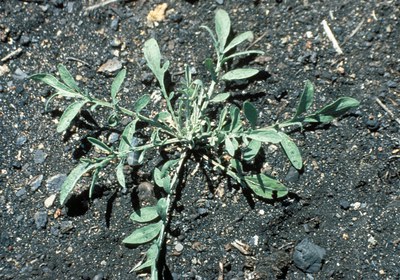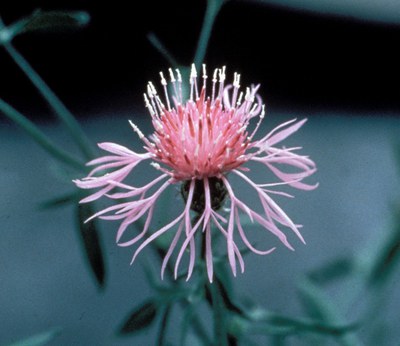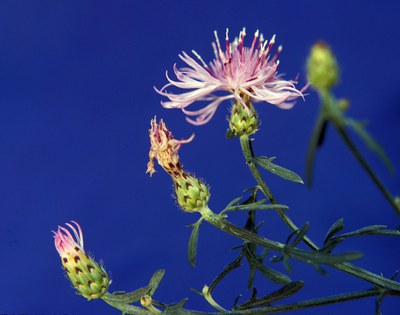Spotted Knapweed (Centaurea maculosa Lam.) (W842)
Spotted knapweed is an aggressive, introduced weed species that rapidly invades pasture, rangeland and fallow land and causes a serious decline in forage and crop production. The weed is a prolific seed producer with 1000 or more seeds per plant. Seed remains viable in the soil five years or more, so infestations may occur a number of years after vegetative plants have been eliminated. Spotted knapweed has few natural enemies and is consumed by livestock only when other vegetation is unavailable. The plant releases a toxin that reduces growth of forage species. Areas heavily infested with spotted knapweed often must be reseeded once the plant is controlled.
Historical records indicate that spotted knapweed was introduced from Eastern Europe into North America in the early 1900s as a contaminant in crop seed. It now infests several million acres of grazing land in the northwestern United States and Canada.
Spotted knapweed infestations in North Dakota have been found primarily along highways, waterways, railroad tracks, pipelines and recently installed utility lines in the western part of the state. Spotted knapweed also has been found in eastern North Dakota. The infestations can largely be traced to seed or hay brought in from neighboring states, especially Montana and Minnesota, which have large areas infested with spotted knapweed. Researchers in other areas have observed that spotted knapweed may remain for several years in a confined location and then spread rapidly to adjacent areas.
Description
Spotted knapweed generally is a short-lived perennial, reproducing solely by seeds. Seeds are brownish, less than ¼ inch long, notched on one side of the base, with a short tuft of bristles at the tip. The seeds may germinate from spring through early fall. Seedlings emerging in the fall often over-winter as a rosette of leaves, resuming growth again in the spring (Figure 1).

The plant grows 2 to 4 feet tall and bears alternate, pale green leaves which are 1 to 3 inches long. Leaf margins of the lower leaves are divided and smooth while the surface of the leaf is rough. The upper leaves are linear in shape. Stems are erect and rough, with slender branches. Numerous flowers are produced from early July through August. Flowers are pink to light purple and are borne on tips of terminal or axillary stems (Figure 2).

The flower petals are surrounded by stiff, black-tipped bracts, giving the flower head a spotted appearance (Figure 3).

Spotted knapweed can be distinguished most easily from Russian knapweed (a long-lived perennial of the same genus) on the basis of floral characteristics. Russian knapweed flowers are smaller than those of spotted knapweed and do not have black mottling on the flower bracts.
Prevention – Management
People are the major cause of spotted knapweed spread. The weed is spread readily in hay and on vehicle undercarriages. Producers should exercise caution when using hay from road ditches, especially primary roadways, and when purchasing hay from known infested areas in neighboring states and provinces.
Producers must learn to identify spotted knapweed and be aware of potential harmful effects before it becomes established. Producers should watch for the weed on their own land, especially on disturbed sites, pastures bordering roads and streams, and where hay is fed. Timely control of a few plants will be very cost effective compared to treating a larger acreage later. The public can assist county weed officials in controlling spotted knapweed by reporting all suspected infestations of the weed.
Pasture and Rangeland
The best spotted knapweed control is prevention. The plant generally is easy to control with herbicides but an area must be monitored for several years and retreated as necessary for seedling control.
Herbicides will control spotted knapweed plants and seedlings for two to three years. The residual control period may be shorter on gravel soils, in wet areas, and where soil organic matter is high. The optimum application time is when the plant is in the rosette growth stage in the fall or in the bud to bloom stage in the spring. Do not use herbicides near water or where a sandy porous surface and substrata overlie ground water 10 feet or less below the surface. Do not allow spray to fall onto surface water, banks or bottoms of irrigation ditches, streams or rivers. Consult label for grazing restrictions.
An annual follow-up treatment for a minimum of two years may be needed to prevent reinfestation by seedlings.
Consult Extension Circular W253 “North Dakota Weed Control Guide” for information concerning which herbicides are best for spotted knapweed control.
Small Infestations
Spotted knapweed confined to small, well defined areas should be treated as soon as detected to avoid spread of the weed. First, all visible spotted knapweed plants should be removed and destroyed. Then the area should be treated with a herbicide to prevent reinfestation from seedlings.
Herbicides can be used to control small infestations. They should be mixed in a hand-held single nozzle sprayer and applied until runoff. Treat an extra 10 to 15 feet around the spotted knapweed patches to control roots and seedlings. A careful follow-up program is necessary to control missed plants and seedlings. Many attempts to control spotted knapweed have failed because follow-up treatments were not applied.
Consult Extension Circular W253 “North Dakota Weed Control Guide” for information concerning which herbicides are best for spotted knapweed control.
July 2013

